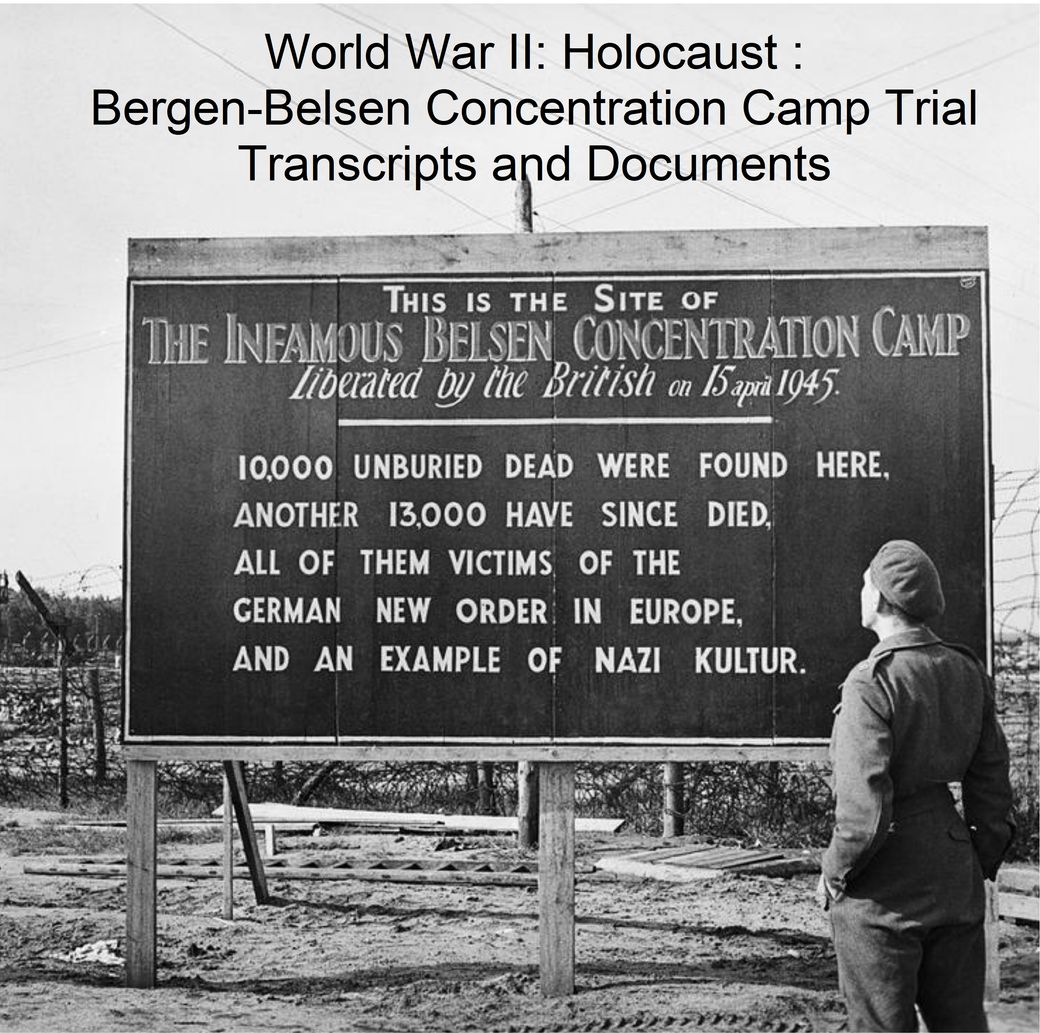
World War II: Holocaust Bergen-Belsen Concentration Camp Trial Transcripts and Documents
$19.50
Description
Bergen-Belsen: Timeline, Key Figures, and The Trial
Pre-1943:
- Until 1943: Bergen-Belsen serves exclusively as a POW camp in Germany, housing Allied prisoners.
1943:
- April 1943: The SS Economic-Administration Main Office (SS Wirtschafts-Verwaltungshauptamt – WVHA), which administers the German concentration camp system, converts a portion of Bergen-Belsen from a POW camp into a civilian residence camp and then into a concentration camp.
1944:
- May 8, 1944: Josef Kramer begins his tenure as commandant of Auschwitz-Birkenau.
- June 9, 1944: A letter from the “German Company for the Control of Vermin” regarding the storage and use of “disinfectant” is created, which is later included in the trial documents concerning Kurt Gerstein’s testimony.
- Fall 1944: The SS begins deporting large numbers of prisoners evacuated from Nazi camps further east to Bergen-Belsen.
- November 25, 1944: Josef Kramer’s tenure as commandant of Auschwitz-Birkenau ends.
- December 1944: Josef Kramer begins his tenure as commandant of Bergen-Belsen concentration camp.
1945:
- February 1945: Anne Frank and her younger sister Margot die of spotted typhus at Bergen-Belsen concentration camp, having been transferred there from Auschwitz.
- April 15, 1945: British forces, specifically the British 11th Armoured Division, liberate Bergen-Belsen concentration camp. They discover approximately 60,000 living prisoners and around 13,000 corpses.
- Fall 1945: The British Government establishes a British Military Tribunal in Lüneburg, Germany, to try Josef Kramer and other SS personnel and prisoner functionaries associated with Bergen-Belsen and Auschwitz.
- September 17, 1945: The first Belsen Trial formally begins.
- November 17, 1945: The first Belsen Trial concludes. The tribunal sentences eleven defendants, including Kramer, to death; convicts and sentences nineteen others to prison terms; and acquits fourteen.
- December 12, 1945: British military authorities execute Josef Kramer and ten of his co-defendants.
Post-1945:
- 1946: The Nuremberg trials are held by the International Military Tribunal, building upon practices established by the Belsen Trial.
- 1947: The United Nations War Crimes Commission publishes “United Nations War Crimes Commission Law Reports of Trials of War Criminals – Volume II the Belsen Trial,” a 172-page report on the trial’s aspects and results.
Overall (Undated but significant):
- Approximately 50,000 people die in the Bergen-Belsen camp complex.
- The Belsen Trial becomes known as the “first great attempt to try and punish people responsible for war crimes in Western Europe.”
Cast of Characters
- Josef Kramer: Commandant of Auschwitz-Birkenau from May 8, 1944, to November 25, 1944, and then commandant of Bergen-Belsen concentration camp from December 1944 until its liberation on April 15, 1945. He was one of the 45 defendants in the first Belsen Trial, sentenced to death, and executed on December 12, 1945.
- Anne Frank: A young Jewish girl who, along with her younger sister Margot, was transferred from Auschwitz to Bergen-Belsen. She contracted spotted typhus and died in February 1945, shortly before the camp’s liberation.
- Margot Frank: Anne Frank’s older sister. She was transferred from Auschwitz to Bergen-Belsen with Anne and also died of spotted typhus in February 1945.
- First Lieutenant Kurt Gerstein: Head of Technical Disinfection Services for the SS. He was barred from State service in 1936 for anti-Nazi activity. He had intimate knowledge of gas chambers and the use of prussic acid at various concentration camps, including Belsen and Auschwitz, and was an eyewitness to multiple gassings. His deposition was included in the trial documents.
- Tadeusz Cyprian: A Polish prosecutor participating in the Belsen Trial. He authored a 5-page introduction to the trial transcripts, highlighting its historical significance as the first mass trial of war criminals dealing with atrocities in camps that symbolized German rule in occupied Europe.
- Unnamed British Officer (Royal Artillery): The officer in charge of Bergen-Belsen camp after liberation, who speaks in Prosecution Exhibit 230 film about the conditions found.
- Unnamed Woman Doctor (Prisoner): A former prisoner at Bergen-Belsen who was in charge of the female section. She describes the horrific conditions in the camp in Prosecution Exhibit 230 film.
World War II: Holocaust Bergen-Belsen Concentration Camp Trial Transcripts and Documents
3,769 pages of trial transcripts, court documents, records, newspaper articles and histories concerning the first Belsen Trial (September 17, 1945 – November 17, 1945) of the commandant of Auschwitz-Birkenau (from 8 May 1944 to 25 November 1944) and of the Bergen-Belsen concentration camp (from December 1944 to its liberation on 15 April 1945) Josef Kramer and 44 others. Kramer and forty-four others were alleged to have been either been full members of the staff of Belsen or Auschwitz concentration camps, or of both, others were prisoners elevated by the camp administrators to positions of authority over the other internees.
The Belsen trial has gone down in history as the first great attempt to try and punish people responsible for war crimes in Western Europe.
Until 1943, Bergen-Belsen was exclusively a POW camp in Germany housing allied prisoners. In April 1943, the SS Economic-Administration Main Office, SS Wirtschafts-Verwaltungshauptamt (WVHA) which administered the German concentration camp system, converted a portion of the camp into a civilian residence camp and, then into a concentration camp. Beginning in the fall of 1944, the SS deported to Bergen-Belsen large numbers of prisoners evacuated from Nazi camps further east. Approximately 50,000 people died in the Bergen-Belsen camp complex.
In late 1944, Anne Frank and her younger sister Margot were taken from Auschwitz to the Bergen-Belsen concentration camp. The two Frank children at Bergen-Belsen contracted spotted typhus and died in February 1945. British forces liberated Bergen-Belsen on 15 April 1945. The British 11th Armoured Division on that day discovered approximately 60,000 living prisoners at the camp and approximately 13,000 corpses lying throughout the camp.
In the Fall of 1945, the British Government established a British Military Tribunal in Lüneburg, Germany, to put on trial camp commandant Josef Kramer, SS personnel and prisoner functionaries. The tribunal sentenced eleven of the defendants including Kramer to death. Nineteen other defendants were convicted and sentenced to prison terms; the tribunal acquitted fourteen. On December 12, 1945, British military authorities executed Kramer and ten of his co-defendants.
The Belsen Trial established practices for further war crimes trials such as the Nuremberg trials held by the International Military Tribunal 1-year later.
This collection contains:
United Nations War Crimes Commission Law Reports of Trials of War Criminals – Volume II the Belsen Trial
A 172-page report on the aspects and results of the trial published in 1947 by the United Nations War Crimes Commission.
Belsen Trial Transcript & Tribunal Papers
2,283 pages of transcripts and documents related to the first Belsen Trial (September 17, 1945 – November 17, 1945).
The documents begin with a 5-page typed introduction to the trial by the Polish prosecutor participating in the trial Tadeusz Cyprian. He wrote, “The Belsen trial is, in my opinion, an outstanding event from the historical point of view. It is the first mass-trial of war criminals, it deals with the atrocities committed in two German concentration camps which became the symbol of German rule in occupied Europe, and it can be considered the final stage of the work we are doing in the Commission.”
Followed by 2,053 pages of English language official trial transcripts. Plus 193 document pages including a synopsis of the case, charge sheet, findings & sentences, death warrants, summary of proceedings, petitions, and defendant summaries.
U.S. Army’s War Crimes Branch Deposition of First Lieutenant Kurt Gerstein
Gerstein was head of Technical Disinfection Services for the SS. He was barred from State service in 1936 for anti-Nazi activity. Gerstein was head of “disinfection” procedures, with intimate knowledge of gas chambers and the prussic acid used at Belsen, Auschwitz, Mauthausen, and Oranienburg and an eyewitness to multiple gassings of concentration camp inmates. Includes listing of anti-Nazis with whom Gerstein associated in Berlin; testimony on the use of prussic acid; and a transcript of a letter from the “German Company for the Control of Vermin,” regarding the storage and use of “disinfectant,” June 9, 1944.
Newspapers
48 pages of full-sheet American Newspapers with coverage of the Belsen Trial in regional newspapers from Washington D.C. and the states of Michigan, Connecticut, and North Carolina.
Film
Prosecution Exhibit 230 Concentration Camps, Belsen Concentration Camp. A 10 minute and 19 seconds film created by the War Department’s Office of the Chief Signal Officer. Includes an officer (of the British Royal Artillery) in charge of the camp after liberation who speaks of conditions at Belsen. A woman doctor, who was a prisoner and in charge of the female section, describes conditions. Includes views of Josef Kramer, camp guards, and inmates.
Bergen-Belsen Captured Camp Records
1,200 pages of German captured records composed of death records from the Bergen-Belsen Concentration Camp along with several information sheets originated or collected by the International Tracing Service (Arolsen).
Related products
-

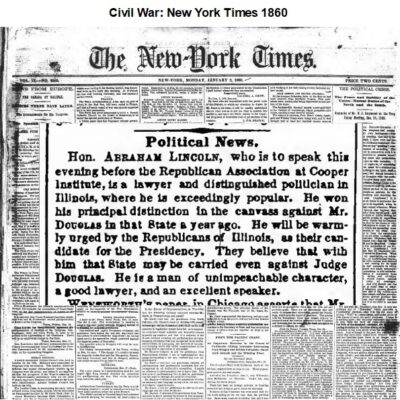
Civil War: New York Times 1860
$9.90 Add to Cart -
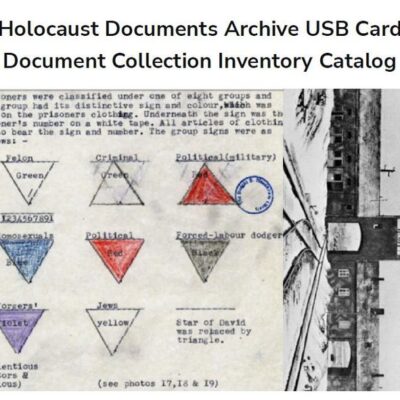
Holocaust Document Archive PDF file – Inventory Catalog of Document Collection
$3.94 Add to Cart -

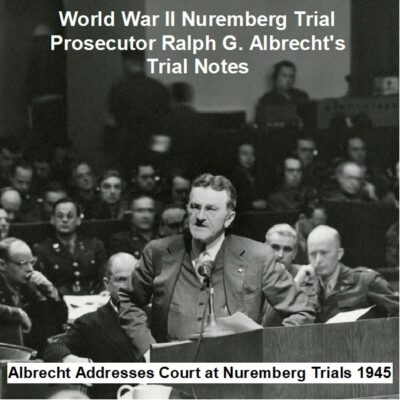
Trial Notes of Ralph G. Albrecht, Prosecutor at the Nuremberg Trials of World War II
$3.94 Add to Cart -
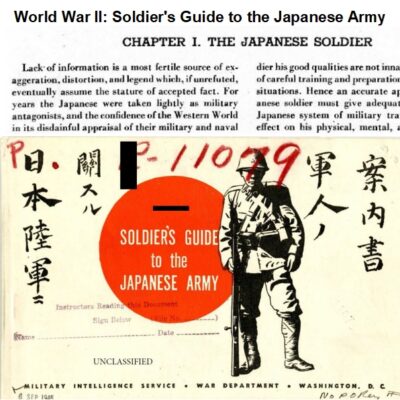

World War II: A Soldier’s Handbook on the Japanese Army
$3.94 Add to Cart